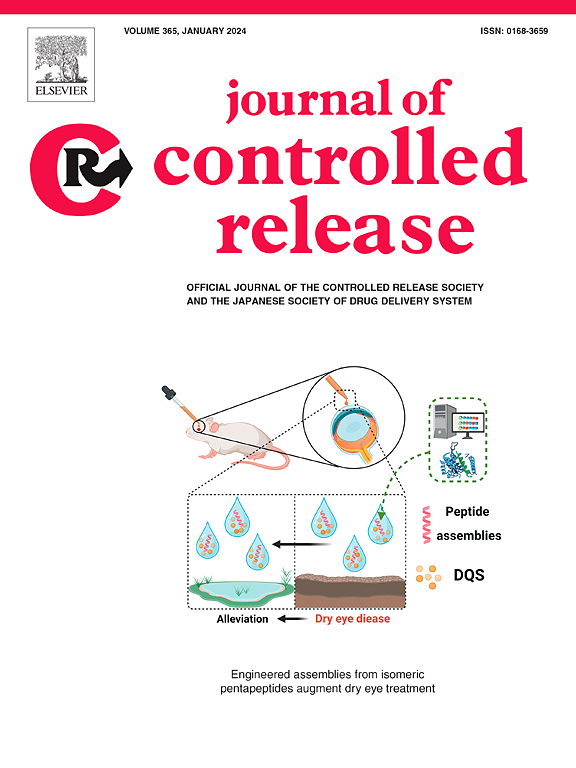自我增强的活性氧反应喜树碱前药纳米颗粒引发安全有效的膀胱内滴注治疗膀胱癌
IF 10.5
1区 医学
Q1 CHEMISTRY, MULTIDISCIPLINARY
引用次数: 0
摘要
膀胱癌仍然是一个重大的临床挑战,需要创新的治疗策略的发展。最近的进展突出了活性氧(ROS)反应性药物递送系统在癌症治疗中的潜力。在这项研究中,我们介绍了一种新的治疗方法,利用活性氧反应喜树碱(CPT)的前药包被壳聚糖纳米载体,命名为CACPT。肉桂醛(CA)作为ROS发生器,与CPT形成硫酮键,产生前药,选择性地响应肿瘤微环境中升高的ROS水平。暴露于高ROS条件下,这些硫酮键被劈裂,导致CPT和CA同时释放。释放的CA进一步增强ROS的产生,建立一个正反馈循环,放大治疗效果。两亲性壳聚糖纳米载体的使用增强了前药在膀胱组织中的保留和渗透,优化了其治疗潜力。我们的实验结果表明,这种自我增强的ros反应性释放促进了细胞摄取的增加,并显著提高了CACPT的抗癌功效。这些结果使CACPT成为膀胱癌原位输注治疗的一个有希望的候选者,有可能克服目前治疗选择的局限性。ros反应机制和壳聚糖纳米载体的创新结合代表了膀胱癌治疗的范式转变,为临床转化提供了多方面的方法。本文章由计算机程序翻译,如有差异,请以英文原文为准。

Self-enhanced ROS-responsive camptothecin prodrug nanoparticles elicit safe and efficient intravesical instillation therapy of bladder cancer
Bladder cancer remains a significant clinical challenge, necessitating the development of innovative therapeutic strategies. Recent advancements have highlighted the potential of reactive oxygen species (ROS)-responsive drug delivery systems in cancer therapy. In this study, we introduce a novel treatment approach utilizing a ROS-responsive camptothecin (CPT) prodrug encapsulated within chitosan nanocarrier, named CACPT. Cinnamaldehyde (CA), acting as a ROS generator, forms thioketal bonds with CPT to create a prodrug that responds selectively to the elevated ROS levels within the tumor microenvironment. Upon exposure to high ROS conditions, these thioketal bonds are cleaved, resulting in the simultaneous release of CPT and CA. The liberated CA further enhances ROS production, establishing a positive feedback loop that amplifies the therapeutic effect. The use of amphiphilic chitosan nanocarriers enhances the retention and penetration of the prodrug within bladder tissue, optimizing its therapeutic potential. Our experimental findings demonstrate that this self-enhanced ROS-responsive release promotes increased cellular uptake and significantly enhances the anticancer efficacy of CACPT. These results position CACPT as a promising candidate for orthotopic infusion therapy in bladder cancer, potentially overcoming current limitations in treatment options. The innovative combination of ROS-responsive mechanisms and chitosan nanocarriers represents a paradigm shift in bladder cancer therapeutics, offering a multifaceted approach with substantial promise for clinical translation.
求助全文
通过发布文献求助,成功后即可免费获取论文全文。
去求助
来源期刊

Journal of Controlled Release
医学-化学综合
CiteScore
18.50
自引率
5.60%
发文量
700
审稿时长
39 days
期刊介绍:
The Journal of Controlled Release (JCR) proudly serves as the Official Journal of the Controlled Release Society and the Japan Society of Drug Delivery System.
Dedicated to the broad field of delivery science and technology, JCR publishes high-quality research articles covering drug delivery systems and all facets of formulations. This includes the physicochemical and biological properties of drugs, design and characterization of dosage forms, release mechanisms, in vivo testing, and formulation research and development across pharmaceutical, diagnostic, agricultural, environmental, cosmetic, and food industries.
Priority is given to manuscripts that contribute to the fundamental understanding of principles or demonstrate the advantages of novel technologies in terms of safety and efficacy over current clinical standards. JCR strives to be a leading platform for advancements in delivery science and technology.
 求助内容:
求助内容: 应助结果提醒方式:
应助结果提醒方式:


